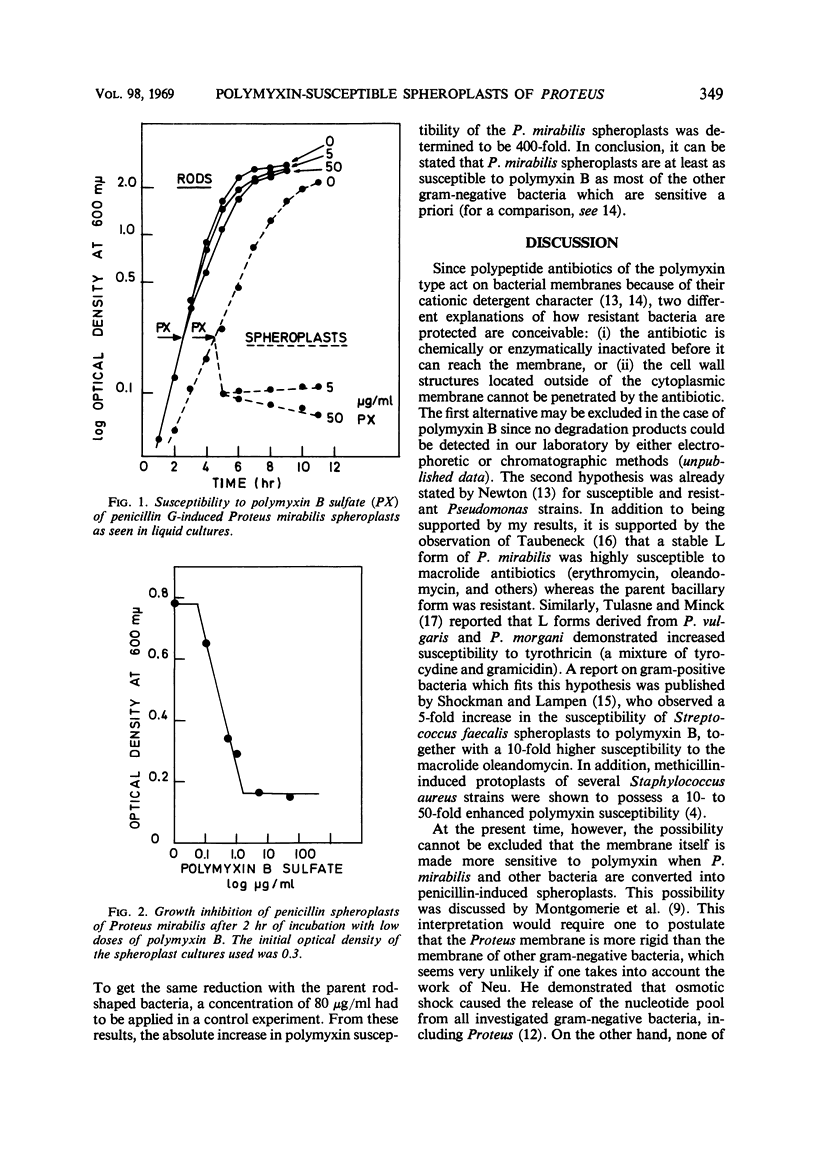Abstract
A polymyxin B-resistant strain of Proteus mirabilis was converted into L forms and spheroplasts in the presence of penicillin G. This treatment caused a 400-fold increase in polymyxin B susceptibility. The acquired susceptibility was in the range of the natural susceptibility reported for susceptible gram-negative bacteria (∼1 μg/ml). The high susceptibility to polymyxin B was lost as soon as the spheroplasts and L forms were allowed to reconvert into the bacillary form in penicillin-free media. This behavior is strong evidence that the natural resistance of Proteus strains to polymyxins is due to the impermeability of the outer cell wall structures to these antibiotic substances.
Full text
PDF



Selected References
These references are in PubMed. This may not be the complete list of references from this article.
- COURTIEU A. L., MONNIER J. J., de LAJUDIE, GUILLERMET F. N. [Antibacterial spectra of colistine for 1200 strains]. Ann Inst Pasteur (Paris) 1961 Apr;100(4):14–31. [PubMed] [Google Scholar]
- Heppel L. A. Selective release of enzymes from bacteria. Science. 1967 Jun 16;156(3781):1451–1455. doi: 10.1126/science.156.3781.1451. [DOI] [PubMed] [Google Scholar]
- KAGAN B. M., ZOLLA S., BUSSER R., LIEPNIEKS S. SENSITIVITY OF COCCAL AND L FORMS OF STAPHYLOCOCCUS AUREUS TO FIVE ANTIBIOTICS. J Bacteriol. 1964 Sep;88:630–632. doi: 10.1128/jb.88.3.630-632.1964. [DOI] [PMC free article] [PubMed] [Google Scholar]
- LATTERRADE C., MACHEBOEUF M. Recherches biochimiques sur le mode d'action de la polymyxine. Ann Inst Pasteur (Paris) 1950 Jun;78(6):753–758. [PubMed] [Google Scholar]
- Montgomerie J. Z., Kalmanson G. M., Guze L. B. The effects of antibiotics on the protoplast and bacterial forms of Streptococcus faecalis. J Lab Clin Med. 1966 Oct;68(4):543–551. [PubMed] [Google Scholar]
- NEWTON B. A. The properties and mode of action of the polymyxins. Bacteriol Rev. 1956 Mar;20(1):14–27. doi: 10.1128/br.20.1.14-27.1956. [DOI] [PMC free article] [PubMed] [Google Scholar]
- Neu H. C., Chou J. Release of surface enzymes in Enterobacteriaceae by osmotic shock. J Bacteriol. 1967 Dec;94(6):1934–1945. doi: 10.1128/jb.94.6.1934-1945.1967. [DOI] [PMC free article] [PubMed] [Google Scholar]
- Neu H. C. The 5'-nucleotidases (uridine diphosphate sugar hydrolases) of the Enterobacteriaceae. Biochemistry. 1968 Oct;7(10):3766–3773. doi: 10.1021/bi00850a059. [DOI] [PubMed] [Google Scholar]
- Neu H. C. The cyclic phosphodiesterases (3'-nucleotidases) of the enterobacteriaceae. Biochemistry. 1968 Oct;7(10):3774–3780. doi: 10.1021/bi00850a060. [DOI] [PubMed] [Google Scholar]
- SHOCKMAN G. D., LAMPEN J. O. Inhibition by antibiotics of the growth of bacterial and yeast protoplasts. J Bacteriol. 1962 Sep;84:508–512. doi: 10.1128/jb.84.3.508-512.1962. [DOI] [PMC free article] [PubMed] [Google Scholar]
- TAUBENECK U. Susceptibility of Proteus mirabilis and its stable L-forms to erythromycin and other macrolides. Nature. 1962 Oct 13;196:195–196. doi: 10.1038/196195b0. [DOI] [PubMed] [Google Scholar]
- TULASNE R., MINCK R. Sensibilité comparée des formes normales et des formes L de deux souches de Proteus vis-à-vis de quelques antibiotiques. C R Seances Soc Biol Fil. 1952 May;146(9-10):778–780. [PubMed] [Google Scholar]
- Weibull C., Bickel W. D., Haskins W. T., Milner K. C., Ribi E. Chemical, biological, and structural properties of stable Proteus L forms and their parent bacteria. J Bacteriol. 1967 Mar;93(3):1143–1159. doi: 10.1128/jb.93.3.1143-1159.1967. [DOI] [PMC free article] [PubMed] [Google Scholar]


